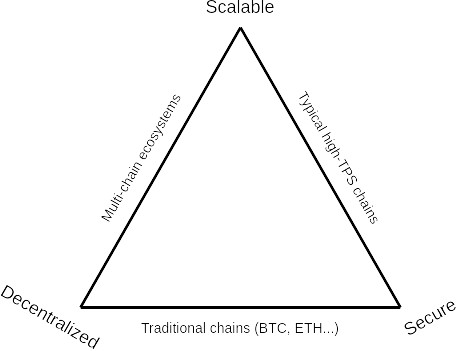Let's Discuss
Enquire NowDeveloping a widely utilized decentralized application on Ethereum, in its current form isn’t nearly ready. The transactions are costly and take a long time to mine. They are significantly slower compared to their centralized counterparts. Although the Merge is a step in the right direction, Ethereum has a long way to go. On many days last year, the average transaction fee exceeded $50, while the price of performing more difficult token swaps was well over $200. The energy needed to carry out crypto mining for Bitcoin and other proof-of-work cryptocurrencies is substantial, more than is utilized by entire nations.
Scalability Trilemma
The scalability trilemma states that a blockchain design can only achieve two of the three properties at a time. These properties are scalability, decentralization(number of nodes), and security.

Off-chain and On-chain Solutions
Typically, every transaction on the blockchain needs to be validated by every node on it. Off-chain (Layer 2) solutions take this burden off the Ethereum chain. On-scale solutions make modifications on the Ethereum blockchain itself(Layer 1) to improve throughput. Together, these solutions are referred to as the modular blockchain. Modular designs can break off from the scalability trilemma as Layer 1 remains highly secure and decentralized, as it looks to Layer 2 solutions for scalability.
Off-chain Solutions
Rollups execute a bundle of transactions outside of layer 1, publishing the compressed data to layer 1 where consensus is reached. Rollup can be thought of as another scalable blockchain linked to Ethereum through smart contracts.
Types of Rollups
Optimistic Rollups assume transactions are valid by default and only run validating computations called fault proofs in the event of a challenge(anyone can challenge the result of the transaction during a set time window called a challenging period). Examples of this implementation are Arbitrum and Optimism.
Currently, these solutions cost ten times less than Layer 1 transactions. Optimistic rollup is designed to be compatible with EVM, so users can deploy existing dApps to Layer 2 easily. However, users must wait for about seven days for the challenge period to pass before withdrawing from an optimistic rollup to Ethereum.
Zero-knowledge (ZK) Rollups run the transactions off-chain and publish cryptographic zero-knowledge proofs (validity proofs) to the chain. Thousands of transactions can be processed in one batch, before publishing their modification summary to the Mainnet. Examples of these rollups are StarkNet and Aztec Protocol.
Lower costs are a significant benefit of moving computation and execution off-chain. A decentralized exchange, Loopring – a ZK-rollup offers traders fees 30-100 times lower than exchanges on Layer 1.
On-chain Solutions
Sharding is the process of splitting a database horizontally. Without sharding, all nodes will have to validate all transactions. With full danksharding, these validators would be distributed across data shards and will only have to validate transactions in their shards, hence more efficient.
Without on-chain solutions, scalability gains of rollups would be linear, as they are limited by the amount of data that can be processed into Layer 1. As Ethereum removes this bottleneck through danksharding, the gains would multiply.
Before introducing danksharding, Ethereum intends to release proto-danksharding. Instead of actually splitting the memory, it introduces a new type of data called blob-data, which is much larger and cheaper than calldata and would be reserved for rollup data.
Conclusion
For achieving significant scalability gains, a larger share of transactions will have to be moved to Layer 2. However, so far in 2022, only a small percentage of total transactions were mined in Layer 2. But the trend is slightly changing. Large projects like Uniswap and Aave are already available on Optimism and Arbitrum.
A combination of Layer 1 and Layer 2 is the future of Ethereum blockchain as it aims to defend its status as the most secure smart contract platform while being the torchbearer for one of the most innovative technologies of our time. According to its founder Vitalik, Ethereum is only 55% done after the Merge and once the journey is complete, it expects to handle 1K transactions per second. Ethereum is set out on its journey to revolutionize Web3 and it has a long way to go.
Have a project in mind that require complex tech stacks? At Dexlock keep ourselves on track with the latest updates from the tech world. We make it a point to arm ourselves with the upcoming technologies in order to provide the best service to our clients. We believe in creating a futuristic world together with other visionaries like us. Connect with us here for more.
Disclaimer: The opinions expressed in this article are those of the author(s) and do not necessarily reflect the positions of Dexlock.



